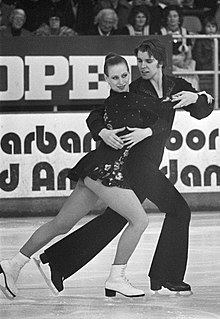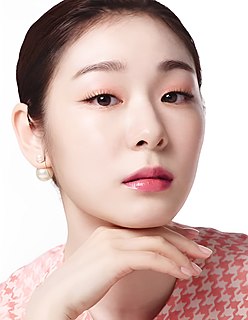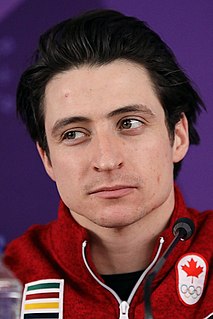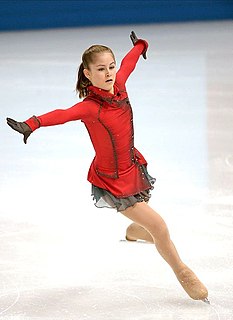
Figure skating is a sport in which individuals, pairs, or groups perform on figure skates on ice. It was the first winter sport to be included in the Olympic Games, when contested at the 1908 Olympics in London. The Olympic disciplines are men's singles, women's singles, pair skating, and ice dance; the four individual disciplines are also combined into a team event, first included in the Winter Olympics in 2014. The non-Olympic disciplines include synchronized skating, Theater on Ice, and four skating. From intermediate through senior-level competition, skaters generally perform two programs, which, depending on the discipline, may include spins, jumps, moves in the field, lifts, throw jumps, death spirals, and other elements or moves.

Ice dance is a discipline of figure skating that historically draws from ballroom dancing. It joined the World Figure Skating Championships in 1952, and became a Winter Olympic Games medal sport in 1976. According to the International Skating Union (ISU), the governing body of figure skating, an ice dance team consists of one woman and one man.

An ice rink is a frozen body of water and/or hardened chemicals where people can ice skate or play winter sports. Ice rinks are also used for exhibitions, contests and ice shows.

Ekaterina "Katia" Alexandrovna Gordeeva is a Russian figure skater. Together with her husband, the late Sergei Grinkov, she was the 1988 and 1994 Olympic Champion and four-time World Champion in pair skating. After Grinkov's death, Gordeeva continued performing as a singles skater.

Brian Joubert is a French former competitive figure skater. He is the 2007 World champion, a three-time European champion, an eight-time French National champion, and the 2006–07 Grand Prix Final champion. In total, he is a six-time World medalist, a ten-time European medalist, and competed in four Winter Olympics for France.

Yuna Kim, also credited in eastern name order as Kim Yuna or Kim Yeon-ah, is a retired South Korean competitive figure skater. She is the 2010 Olympic champion and 2014 silver medalist in ladies' singles, the 2009 & 2013 World champion, the 2009 Four Continents champion, a three-time Grand Prix Final champion, the 2006 World Junior champion, the 2005 Junior Grand Prix Final champion, and a six-time South Korean national champion.

Daisuke Takahashi nicknamed "Dice-K", is a Japanese figure skater. He is the 2010 Olympic bronze medalist, the 2010 World champion, the 2012–13 Grand Prix Final champion, a two-time Four Continents champion, and a five-time Japanese national champion.

Tessa Jane McCormick Virtue is a Canadian retired ice dancer. With ice dance partner Scott Moir, she is the 2010 and 2018 Olympic champion, the 2014 Olympic silver medalist, a three-time World champion, a three-time Four Continents champion, the 2016–17 Grand Prix Final champion, an eight-time Canadian National champion, the 2006 World Junior champion and the 2006 Junior Grand Prix gold medalists. Virtue and Moir are also the 2018 Olympic gold medalists in the team event and the 2014 Olympic silver medalists in the team event. Upon winning their third Olympic gold medal, they became the most decorated Canadian ice dance team of all time and the most decorated Olympic figure skaters of all time. Widely regarded as one of the greatest ice dance teams of all time, they are the only ice dancers in history to achieve a Super Slam, having won all major competitions in their senior and junior careers. Virtue and Moir are holders of the world record score for the now-defunct original dance.

Scott Patrick Moir is a Canadian retired ice dancer and coach. With ice dance partner Tessa Virtue, he is the 2010 and 2018 Olympic champion, the 2014 Olympic silver medalist, a three-time World champion, a three-time Four Continents champion, the 2016–17 Grand Prix Final champion, an eight-time Canadian national champion, the 2006 World Junior champion and the 2006 Junior Grand Prix champion. Moir and Virtue are also the 2018 Olympic gold medalists in the team event and the 2014 Olympic silver medalists in the team event. Upon winning their third Olympic gold medal, they became the most decorated Canadian ice dance team of all time and the most decorated Olympic figure skaters of all time. Widely regarded as one of the greatest ice dance teams of all time, they are the only ice dancers in history to achieve a Super Slam, having won all major competitions in their senior and junior careers. Virtue and Moir are holders of the world record score for the now-defunct original dance.

Figure skating was first contested in the Olympic Games at the 1908 Summer Olympics. Since 1924, the sport has been a part of the Winter Olympic Games.
The following is a glossary of figure skating terms, sorted alphabetically.
A figure skating competition is a judged sports competition in figure skating.

Madison L. Hubbell is an American ice dancer. With partner Zachary Donohue, she is a two-time 2022 Winter Olympics medalist, a three-time World medalist, the 2018 Grand Prix Final champion, the 2014 Four Continents champion, and a three-time U.S. national champion.

Alexandra "Sasha" Zaretsky is an Israeli retired ice dancer. With her brother Roman Zaretsky, she is the 2009 Skate America bronze medalist, 2009 Golden Spin of Zagreb champion, a three-time Nebelhorn Trophy medalist, and a three-time Israeli national champion. They finished as high as sixth at the World Championships and competed twice at the Winter Olympics, finishing tenth in 2010.

Jeremy Abbott is a former American figure skater. He is the 2008 Grand Prix Final champion, a two-time Four Continents bronze medalist, and a four-time U.S. national champion. He represented the United States at the 2010 Winter Olympics, where he placed ninth, and at the 2014 Winter Olympics, winning a bronze medal in the team event.

Maia Harumi Shibutani is an American ice dancer. Partnered with her brother Alex Shibutani, she is the 2018 Olympic bronze medalist, a three-time World medalist, the 2016 Four Continents champion, and a two-time U.S. national champion. The siblings have won six titles on the Grand Prix series and stood on the podium at 14 consecutive U.S. Championships, at five levels including eight as seniors. They are two-time members of the US Olympic team, competing at the 2014 and 2018 Winter Olympics. In 2018, the siblings became the first ice dancers who are both of Asian descent to medal at the Olympics. They are the second sibling duo to ever share an ice dancing Olympic medal, and the first from the United States. The Shibutani siblings are often referred to by their nickname the Shib Sibs.

Yulia Vyacheslavovna Lipnitskaya is a Russian retired competitive figure skater. She was part of the Russian team to win the 2014 Winter Olympics team trophy. Individually, Lipnitskaya is the 2014 World silver medalist, the 2014 European champion, the 2013–14 Grand Prix Final silver medalist, and a two-time Russian national silver medalist. Competing as a junior, Lipnitskaya won the 2012 World Junior Championships, 2011–12 JGP Final, and 2012 Russian Junior Championships. She retired from the professional sport on 9 September 2017 due to complications with ligaments of the legs and hip joints, as well as anorexia.

Alexa Scimeca Knierim is an American pair skater. With her skating partner, Brandon Frazier, she is the 2021 U.S. National Champion and the 2020 Skate America Champion. With her husband and former skating partner, Chris Knierim, she is a 2018 Olympic bronze medalist in the figure skating team event, a two-time Four Continents medalist, a three-time Grand Prix medalist, and a three-time U.S. National Champion. At the 2018 Winter Olympics, the Knierims became the first American pair, and the second pair ever in history, to perform a quad twist at the Olympic Games.

A figure skating rink is an ice rink designed for figure skating. Alternatively it is used for other sports such as short track speed skating and ice hockey. It is usually rectangular.

The compulsory dance (CD), now called the pattern dance, is a part of the figure skating segment of ice dance competitions in which all the couples or solo dancers perform the same standardized steps and holds to music of a specified tempo and genre. One or more compulsory dances were usually skated as the first phase of ice dancing competitions. The 2009–10 season was the final season in which the segment was included in International Skating Union (ISU) junior and senior level competition. In June 2010, the ISU replaced the name "compulsory dance" with "pattern dance" for ice dance, and merged it into the short dance (SD) beginning in the 2010–11 figure skating season.


















